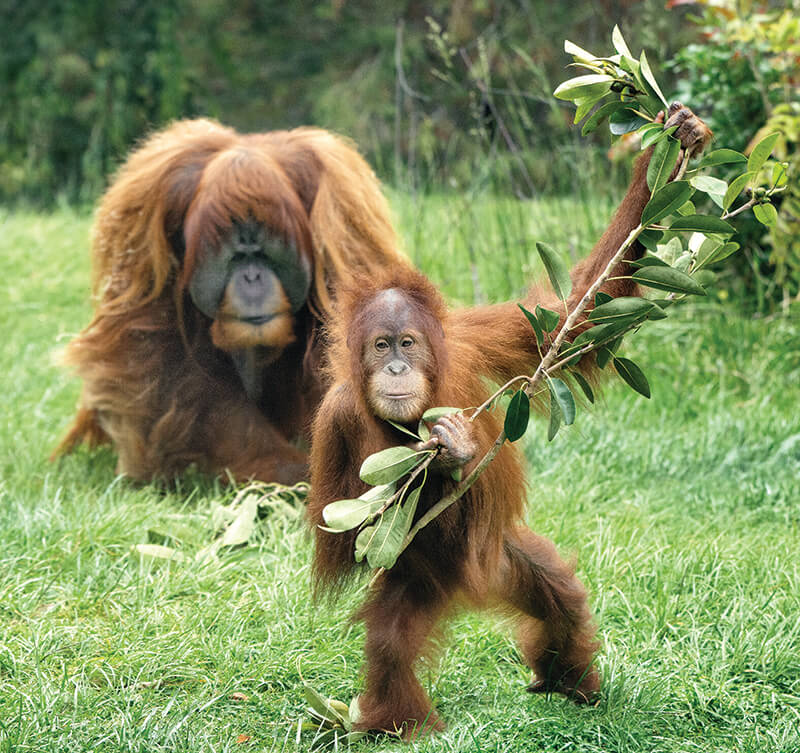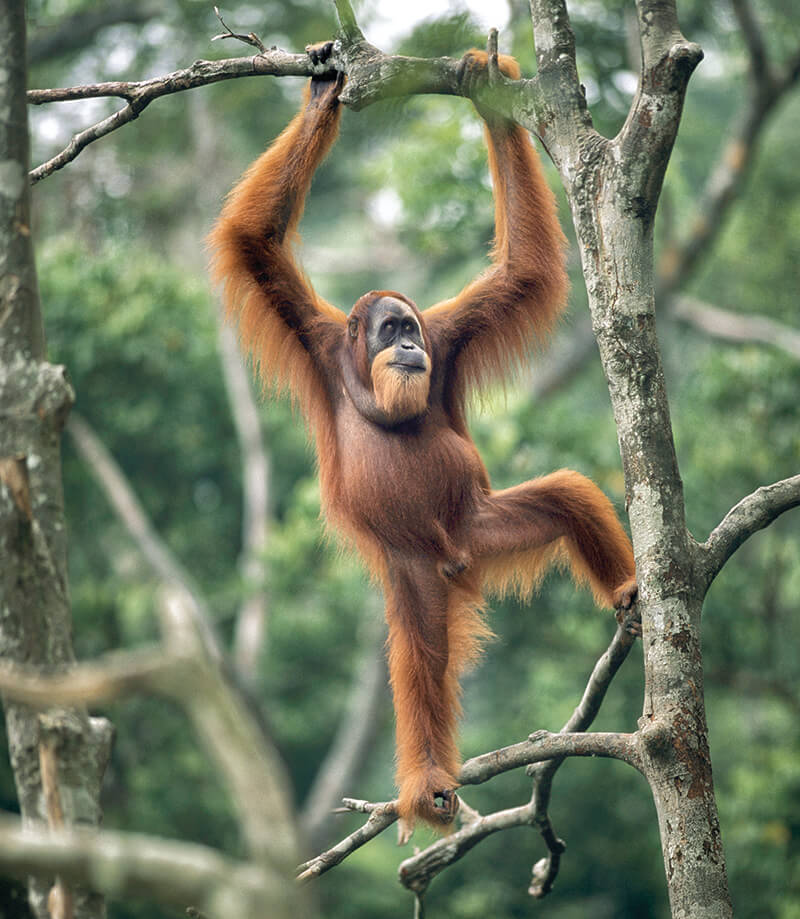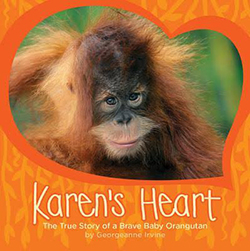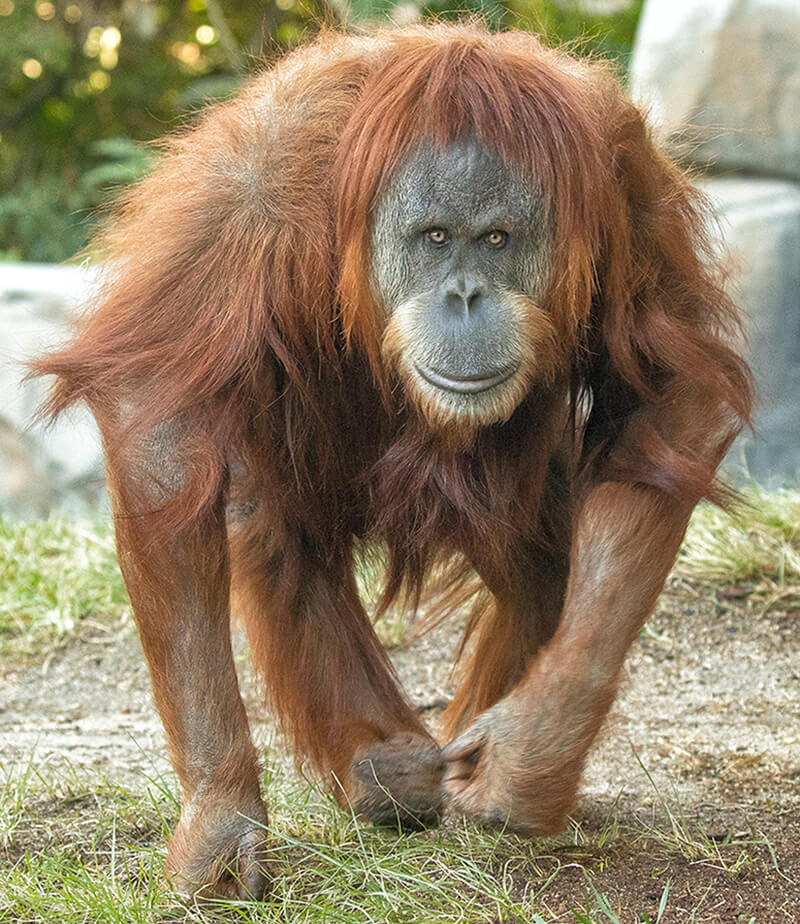
If you want to spot an orangutan in the wilderness of Borneo or Sumatra, you’ll have to look up. The world’s largest arboreal mammal, these shaggy red apes spend most of their life in the trees, feasting on ripe fruit and climbing, clambering, walking, and swinging confidently from branch to branch. With arms longer than their body; long, strong fingers; and grasping toes, life in the trees is a breeze for an orangutan. Females raise their offspring and even give birth high in the rainforest. [caption id="attachment_139243" align="aligncenter" width="800"] GROWING AND LEARNING
GROWING AND LEARNING
Young orangutans spend their first seven or eight years learning where in the forest to find fruit, how to build a nest, and other survival techniques. (Photo by: Ken Bohn/SDZWA)[/caption] At the San Diego Zoo, the orangutan habitat mimics their rainforest home, with climbing structures joined by ropes and nets that help create aerial pathways through the habitat. Without predators like clouded leopards, Sumatran tigers, giant pythons, and crocodiles to avoid, orangutans at the Zoo are also quite comfortable on the ground. They spend time in and around rocky caves and human-made “termite mounds” that are sometimes filled with food for the orangutans to retrieve. [caption id="attachment_139240" align="aligncenter" width="800"] FOREST PEOPLE
FOREST PEOPLE
The name orangutan means “people of the forest.” Life high in the trees is a breeze for these great apes. (Photo by Anup Shah/DigitalVision/Getty Images)[/caption]
 Click here to read the inspiring true story of Karen's open heart surgery in the award-winning children's book here!
Click here to read the inspiring true story of Karen's open heart surgery in the award-winning children's book here!Other apes live in social groups, but orangutans are a little different. Experts used to think they were solitary, but recent studies tell us more. Although adult males generally avoid each other, where food is abundant, orangutans are a bit more social. The hypothesis is that the orangutans’ semi-solitary social system may have evolved as a result of their diet—ripe fruits are scattered over a wide area, so orangutans also have to spread out, so they can all get enough food. In zoos, orangutans don’t have to spread out to forage, and they often do well in socialized groups that include adult males. It’s not unusual to see male Satu interacting with—or at least patiently tolerating—the other apes in the habitat, especially the young and playful, like seven-year-old Aisha. “Seeing those positive interactions is a large part of what drives our day, and we are always looking for what we can do to make those behaviors as frequent as possible,” says Tanya Howard, a wildlife care specialist at the Zoo. “The excitement that a guest has when they watch the orangutans and see their natural behaviors—whether here at the Zoo, or at home watching on Ape Cam—is the same stuff that excites us.” [caption id="attachment_139245" align="aligncenter" width="800"] DID YOU KNOW?
DID YOU KNOW?
Orangutans are the only great apes in Asia—all other great ape species live in Africa. (Photo by: Ken Bohn/SDZWA)[/caption]
Help for Orangutans
In Indonesia and Malaysia, Sumatran and Bornean orangutans are Critically Endangered, and they face some serious threats to their survival. Palm oil plantations have taken over much of their forest habitat, and poachers target young orangutans for the illegal pet trade. San Diego Zoo Wildlife Alliance supports the Association of Zoos and Aquariums’ (AZA) Saving Animals From Extinction (SAFE) Orangutan Program. The goal is to protect and restore wild orangutan populations and their habitats through public engagement, funding, and field work that focuses mainly on habitat protection, rescue and rehabilitation, and capacity enhancing. Together, we are working to keep healthy populations of these beloved, shaggy, red apes thriving, high in the trees on Borneo and Sumatra. [caption id="attachment_139247" align="aligncenter" width="2400"] MEET THE SAN DIEGO ZOO'S ORANGUTANS
MEET THE SAN DIEGO ZOO'S ORANGUTANS
1. SATU: Mature male Satu is easy to recognize with his thick cheek pads, pendulous throat sac, and long hair. He is the only adult male orangutan at the Zoo.
2. KAREN: The only member of the orangutan group to be hand raised at the San Diego Zoo as an infant, Karen survived a widely publicized open-heart surgery in 1994, and she remains a guest favorite.
3. INDAH: Indah typically spends more time in the treetops and climbing structure than on the ground. The 34-year-old female is the capable dam (mother) of Aisha as well as 17-year-old Cinta, a male who now resides at the Saint Louis Zoo and is a sire himself.
4. AISHA: The bond between Indah and seven-year-old Aisha is strong. Orangutans have the slowest breeding rate of all mammals. Infants nurse and stay with their dams for seven or eight years.[/caption] (Top photo: USO/Getty Images Plus)




